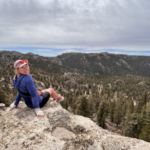Post Fire Treatments – The first three years after the burn.
Soil and Water Conservation
One of the biggest natural resource concerns following a fire is the loss of vegetative cover on the landscape. This leads to extreme soil erosion concerns, which can have negative impacts on the ecosystem and water quality. Although there may be more pressing concerns to deal with such as dangerous hazard trees, excessive woody debris, and infrastructure losses, it is important to consider getting some vegetation established within the first two to three years after a fire to prevent erosion, and landslides during the rainy seasons.
Although seeding may not be the most effective immediate after a fire, as the seeds may not be able to germinate, and there’s likely risk of seed washing off in rains, it’s helpful to add to the landscape during the second year post fire. One of the ways to prevent further damage is to seed the bare soil with fast growing, annual seed that will protect the soil through the winter; native species is preferred. View this NRCS guide to immediate post fire seeding for species and rates recommendations. Always make sure there’s no noxious invasive weed species in the seed mix!
Mulch and Erosion Control
Although seeding may help in some areas with severe burn and erosion hazard, it’s not always the most effective method for stabilizing slopes right after a fire. In addition to seeding, or in areas where seeding is not needed, always use a natural fiber mulch like straw; Be aware that some straw mulch may contain weed seeds, so using rice straw is usually best. For areas on steep slopes or near waterways, use straw wattles, straw-bale check dams, and contour log placements to prevent runoff and erosion.
Visit OSU Extension’s ‘Methods for mitigating soil erosion after a fire‘ for more information.
Restoration for Long Term Recovery
Why native plants for restoration?
Native plants have several benefits:
- Native plants provide food and shelter for wildlife and pollinators, and they are usually easy to grow.
- Native plants are adapted to the local climate and soils, and can tolerate the cool, wet winters and warm dry summers we have in the Willamette Valley.
- They do not require added fertilizers, and once established after a year or two of summer watering (if possible), they rarely need supplemental water.
- Native plants are beautiful and are naturally resistant to many diseases and pest problems.
Here is a short list of native trees, shrubs and ground-cover/flowering plants for areas burned. The lists are separated into plants for upland areas (away from water) and stream side areas (near a water source).
Trees
| Upland | Streamside |
|---|---|
| Douglas Fir (Pseudotsuga menziesii) | Oregon Ash (Fraxinus latifolia) |
| Willamette Valley Ponderosa Pine (Pinus ponderosa) | Bitter cherry (Prunus emarginata) |
| Bigleaf Maple (Acer macrophyllum) | Black Cottonwood (Populus trichocarpa) |
| Cascara (Rhanmus purshiana) | Red Alder (Alnus rubra) |
| Beaked Hazelnut (Corylus cornuta var californica) | Western/Oregon Crabapple (Malus fusca) |
Shrubs
| Upland | Streamside |
|---|---|
| Cascade Oregon Grape (Mahonia nervosa) | Red-Osier Dogwood (Cornus sericea) |
| Oceanspray (Holodiscus discolor) | Douglas Spirea (Spiraea douglasii) |
| Western Serviceberry (Amelanchier alnifolia) | Pacific Ninebark (Physocarpus capitatus) |
| Salal (Gaultheria shallon) | Willow: Sitka or Pacific (Salix sitchensis/lasiandra) |
| Common Snowberry (Symphoricarpus albus) | Red Elderberry (Sambucus racemosa) |
| Nootka Rose (Rosa nutkana) | Swamp/Cluster Rose (Rosa pisocarpa) |
| Thimbleberry (Rubus parviflorus/nutkana) |
Groundcover/Flowering Plants
| Upland | Streamside |
|---|---|
| Sword Fern (Polystichum munitum) | Streambank lupine (Lupinus rivularis) |
| Kinnikinnick (Arctostaphylus uva-ursi) | Soft Rush (Juncus effusus) |
| Oregon Iris (Iris tenax) | Pacific Waterleaf (Hydrophyllum tenuipes) |
| Common Self heal (Prunella vulgaris var lanceolata) | Big Leaf Lupine (Lupinus polyphyllus) |
| Broad petal strawberry (Fragaria virginiana) | Blue-Eyed Grass (Sisyrinchium idahoense) |
| Common Yarrow (Achillea millefolium) | Slough sedge (Carex obnupta) |
| Douglas Aster (Symphyotrichum subspicatum) | Dagger-leaved rush (Juncus ensifolius) |
Planting Notes
- Control competing vegetation around native plants for ~ 5 years to help reduce competition for sunlight, water and other nutrients. Keep an area ~ 2ft in diameter clear of vegetation around the plants by mowing, hand pulling or careful herbicide application.
- Apply water during hot summer months if possible.
- General planting density is 300-400 trees/acre in upland areas, which is about 11 to 12 ft spacing. If using shrubs and flowering plants, planting density is higher. Shrubs can be planted at ~6 ft spacing and flowering plants can be as close as 1 ft.
- Along streams, plant at a density of 2-3 ft spacing to help control erosion and crowd out undesirable species.
- Control all invasive and noxious vegetation in planting area, if possible. Many invasive plants that were present before the fire will most likely resprout after the fire. A few high priority invasive species in the fire area include: Italian Thistle, false brome, meadow, spotted and diffuse knapweeds, yellow archangel, garlic mustard and knotweeds. https://northsantiam.org/post-fire-recovery-invasives/
- Other species that should be controlled to ensure success of plantings or naturally regenerating native plants are: Armenian blackberry, Scotch broom, English Ivy, tansy ragwort, bull thistle, Canada thistle.
- Information for Marion SWCD’s Annual Native Plant Sale and Scholarship Fundraiser will be posted on our website later this winter.
Marion County information
For more information on restoring a property, debris removal, septic information, FEMA disaster assistance and more, please visit the Marion County Building and Planning Division Resources and Information Packet.
Contact Us
Our staff can help you with all your restoration projects.

